Update your browser to view this website correctly. View list of available browsers
One of the greatest barriers to the provision of seating and wheeled mobility is first identifying the need and then documenting and justifying that need for equipment. This guide is meant to be a helpful resource to healthcare professionals
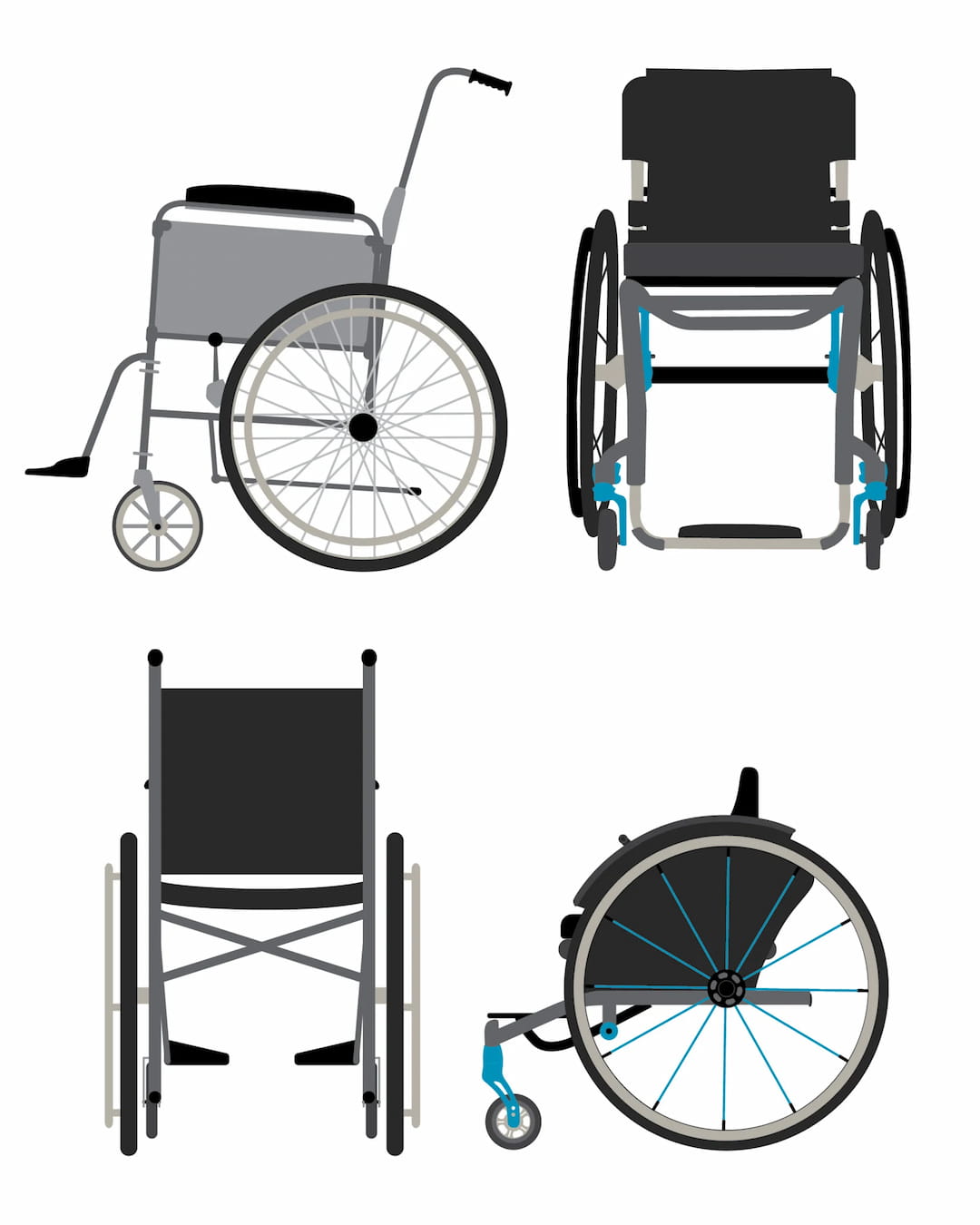
One of the greatest barriers to the provision of seating and wheeled mobility is first identifying the need and then documenting and justifying that need for equipment. This guide is meant to be a helpful resource to healthcare professionals to:
Look for these info boxes throughout the guide. They include quick tips or takeaways for that section.
.jpg)
Chapter 1
Our guide to Wheeled Mobility 101 goes over identifying the need for wheeled mobility so check out that information here. Once you document your patient's need for wheeled mobility you can move on to the next step of qualifying for a manual wheelchair.
Wheelchair selection is not diagnosis specific and requires evidence of medical necessity. Step one is a physician's visit with notes that state:
Mobility related diagnosis - e.g. hemiplegia due to stroke
Then, a referral is made to PT/OT and the fun begins! It becomes our task to evaluate the client and determine what level of wheeled mobility they need to lead safe, functional lives.
The documentation must match from MD to PT/OT! If the MD says they can ambulate or if a diagnosis code does not match, it will be a problem.
Prior to choosing the type of wheelchair, the PT/OT needs to justify the need for a manual wheelchair.
Ask yourself the following questions, and the answers will begin to guide you towards the right wheelchair:
1. Does your client have a mobility limitation that significantly impairs his/her ability to participate in one or more MRADLs in the home?2. Can the mobility limitation be resolved by a cane or walker?
3. Do they have the desire or capability to propel a wheelchair?
4. Does the client’s home have the space/layout for functional wheelchair use?
Always document how the right equipment allows them to perform routine tasks more independently.
Keep in mind the 5-year lifetime rule. Many insurers will not pay for new equipment unless the current equipment is more than 5 years old or there has been a significant change in medical condition.
If your client uses a wheelchair already, ask the following:
Just because a person already has a wheelchair, it doesn’t mean it’s the most appropriate one for them!
Chapter 2
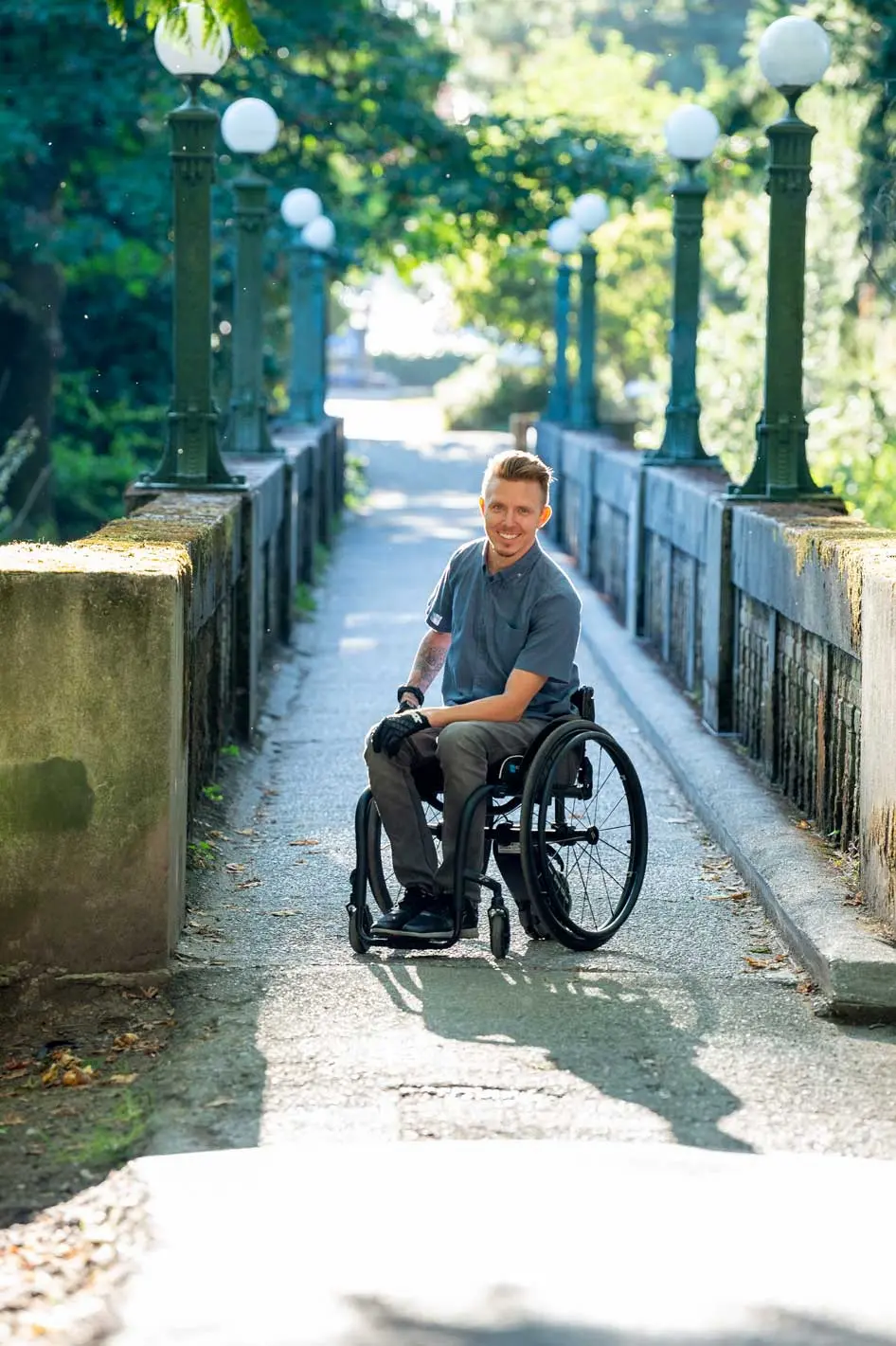
Let's start with the basics. When it comes to seating and wheeled mobility, products are divided into two groups:
Durable Medical Equipment (DME) and Complex Rehabilitation Technology (CRT).
Check out Wheeled Mobility 101 for more information on DME and CRT equipment.
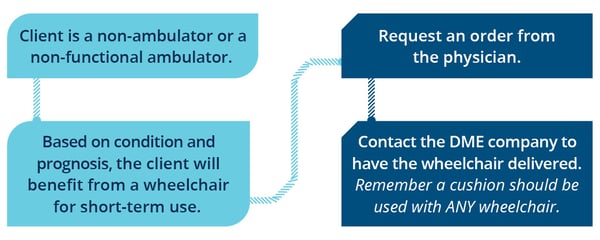
You are not limited to the type of wheelchair that your client has used in the past if they could benefit from better equipment.
People, circumstances, legislation, and technology all change over time. If your client already has a wheelchair, it does not automatically mean that it is the most appropriate choice for them now or that it necessarily ever was.
You also have the option to provide ANY type of seating and positioning equipment, even CRT products, for a DME wheelchair if it benefits your client.
It is up to you to advocate for your clients. Perform your evaluations to help justify the proper equipment choices to address your clients' needs now and over time as best you can.
Just because a model of wheelchair was used historically by your client, it doesn’t mean their new equipment should be limited to the same technology.
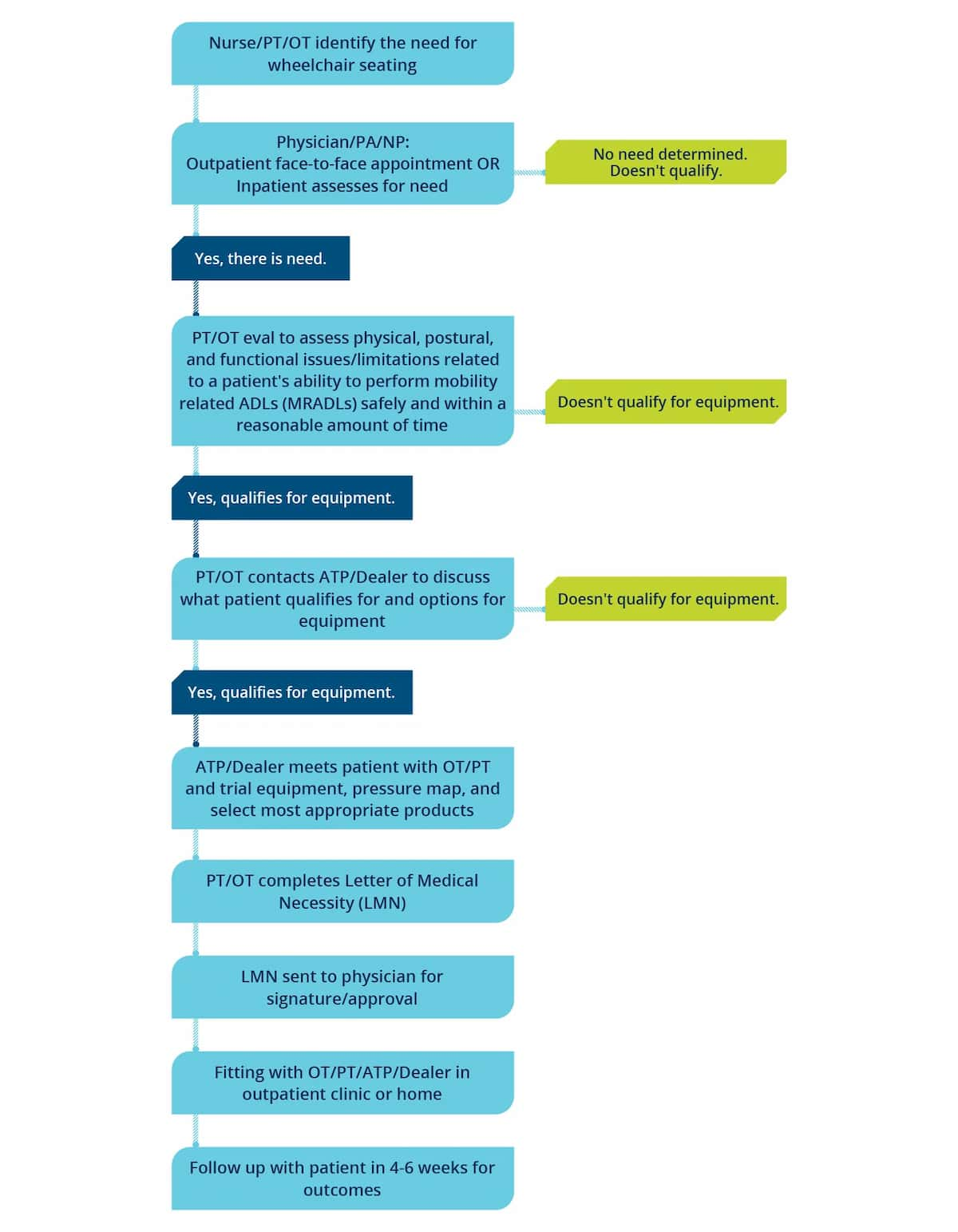
This guide will help you more easily identify the most appropriate mobility device.
| Standard | Standard Hemi Height | Lightweight | High-Strength Lightweight | Tilt-in-Space | Ultra Lightweight | |
| Equipment Category: | DME | DME | DME | DME | CRT | CRT |
| Medicare Code: | K0001 | K0002 | K0003 | K0004 | E1161 | K0005 |
| Meant for long-term sitting? | No | No | No | Only w/ appropriate configuration | Yes | Yes |
| Dimensions: | ||||||
| Wheelchair weight without legrests | >35 lbs | >35 lbs | 33-35 lbs | 30-34 lbs | >45 lbs | <30 lbs |
| Seat width: standard | 16", 18", 20" | 16", 18", 20" | 16", 18", 20" | 16", 18", 20", 22" | 16", 18", 20" | Customizable |
| Seat depth: standard | 16" | 16" | 16", 18" | 16", 18", 20" | 16", 18", 20" | Customizable |
| Weight capacity | 300 lbs | 300 lbs | 300 lbs | 300 lbs | 300 lbs | Customizable |
| Back height | 18" | 18" | 18" | 16" to 20" | 24" | Customizable |
| Lowest achievable seat-to-floor height | 21" | 19" | 17" | 13.5" (most 14.5") | 17" | Customizable |
| Adjustability to accommodate for postural abnormality: | ||||||
| Arm rest height | No | No | No | Yes | Yes | Yes |
| Back height | No | No | No | Yes | Yes | Yes |
| Seat-to-back angle | No | No | No | Yes | Yes | Yes |
| Ability to create a fixed tilt | No | No | No | Yes | Yes | Yes |
| Seat-to-floor height (STFH) | No | Hemi height only | Yes | Yes | 17"-21" | Yes |
| Legrest options: | ||||||
| Standard, elevating (ELR), & swing away | Yes | Yes | Yes | Yes | Yes | Yes + more |
| Heavy duty wheelchairs | ||||||
| DME K0006-K0007 | ||||||
| Same structure and features as K0001-K0003 MWCs, but reinforced for greater weight capacity. | ||||||
Note: This chart is for reference purposed only. Wheelchair features vary according to manufacturer and model.
Short-term (and/or part-time) means that the client will only need a wheelchair for a period of time, temporarily during recovery from surgery or mild to moderate injury, and they are not at risk for postural issues or pain. They might use the wheelchair for short periods of time throughout the day and/or for longer distances to reduce fatigue. Below are the types of short-term use wheelchairs:
Long-term (and/or full-time) means that the client will need a wheelchair indefinitely as their primary means of mobility whether independent or dependent. Below are types of long-term use wheelchairs:
A K0005 wheelchair is the BEST PRACTICE for any full-time wheelchair user!! The K0004 is never "good enough." Below are topics related to the K0005 ultra lightweight manual wheelchair.
Chapter 3
| Configuration options | Why it matters |
|
Front seat-to-floor height (FSTFH) |
Important for safe functional use during propulsion and transfers |
|
Rear seat-to-floor height (RSTFH) |
Determines rear wheel accessibility and efficiency of propulsion |
|
Seat slope: difference between the FSTFH & RSTFH |
Important for postural stability and optimal wheel access for self-propulsion |
|
Foot support-to-seat length |
This affects LE positioning, femoral contact for pressure redistribution, and foot plate clearance |
|
Front frame angle |
Legs and feet brought closer to the body make the overall WC footprint smaller, making it easier to get close to things for reaching |
|
Overall frame length |
A proper frame length ensures the wheelbase is proportional to the client |
|
Seat width |
Affects posture, wheel access for propulsion, and environmental access |
|
Seat depth |
Optimizes posture and pressure redistribution |
|
Seat back height |
An optimal back support height will balance postural stability and functional reach for ADLs |
|
Seat-to-back angle |
This angle provides optimal pelvic and trunk support for stability and daily function |
|
Horizontal & vertical rear wheel axle position |
This can be configured for optimal center of gravity and wheel access for the most efficient push stroke |
|
Rear wheels |
Affects propulsion, rolling resistance, and weight |
|
Rear wheel camber |
Used to increase lateral stability and turning efficiency |
|
Casters |
Stability, rolling resistance, and maneuverability |
A K0005 is an individually configured, tailor-fit wheelchair. It is not merely small, medium, or large.
The features of a manual wheelchair will significantly affect the client and performance of the wheelchair in terms of postural support and wheelchair stability, maneuverability, and ease of propulsion.
This is why the ability to configure a K0005 wheelchair is best practice for a person who uses a wheelchair long-term.
Relating the client's measurements to the wheelchair specifications is key!
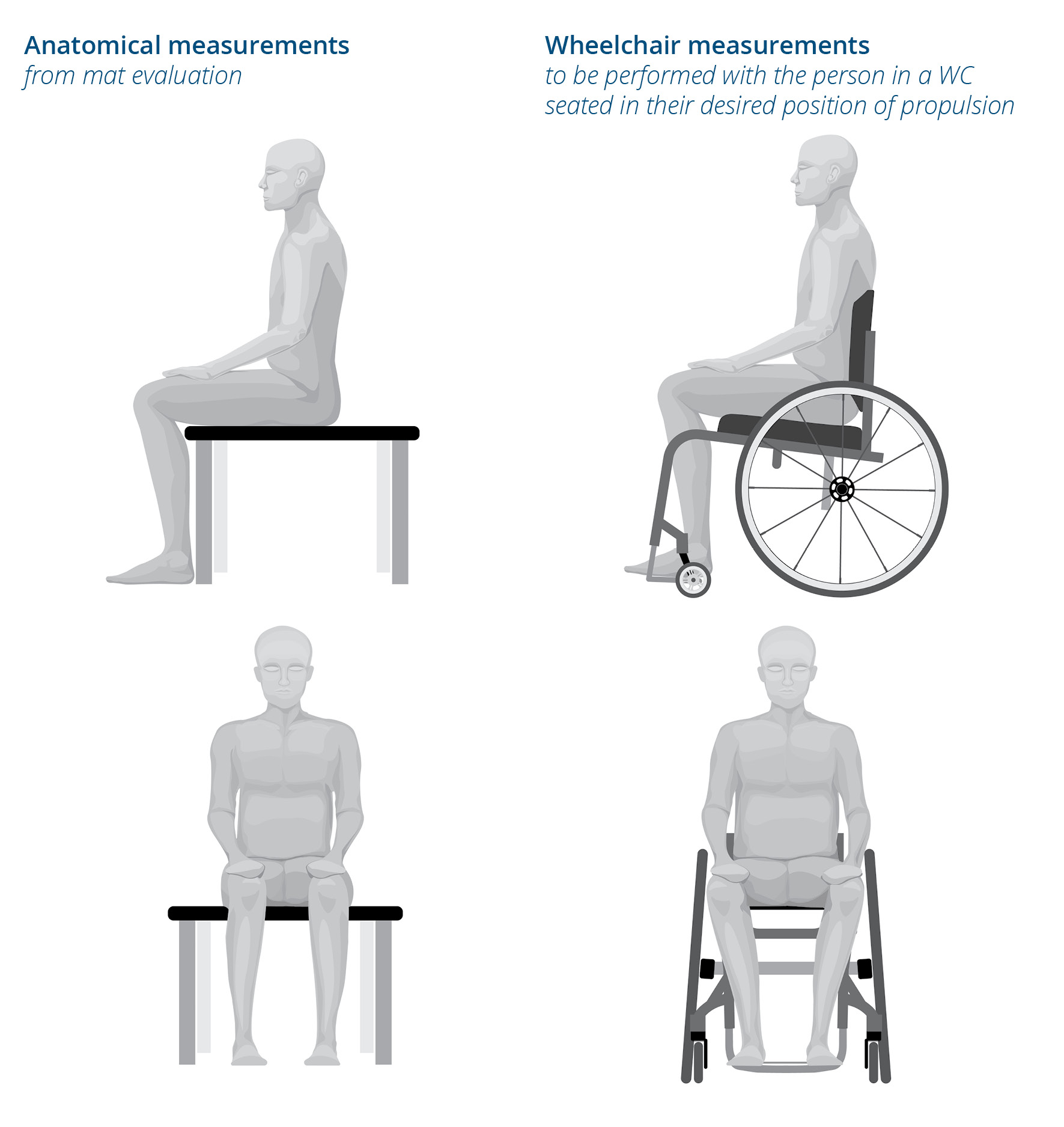
Below are the specific measurements and configurations
There are a variety of additional options for K0005 wheelchairs because they are truly the most customizable MWC option. Some are for function, but may not be necessary for every client while others are more client preference.
| Configuration options | Considerations |
|
Handrim and wheel lock style |
Affect use and propulsion (especially for those with limited dexterity), otherwise may be heavily dependent on client preference |
|
Foot plate style |
Affects safe foot placement/positioning Options may include rigid, adjustable, swing-away, flip-up, and flip-back |
|
Arm rest (optional) style, height, attachment |
May be needed to promote postural stability May provide a resting place to reduce fatigue Height can affect optimal wheel access Style can affect reaching and transfers Options may include: adjustable, swing-away, flip-up, and removable. Full and desk length |
|
Side guards (optional) adjustable and/or removable |
Consider for postural support and stability Can provide protection from the wheels during use Reducing wheel resistance if wheels come in contact with cushion, clothing |
|
Anti-tips |
Safety feature for some environments and terrain. May be fixed, flip-up, removable |
|
Push handles |
Will the client be pushed a fair amount of the time? Can added push handles help them maneuver the WC before and after transfer? |
The setup of a K0005 MWC demands knowledge of client’s history and potential for function. If not done correctly, the client may not realize that they are at a disadvantage, and it can have long-term effects. Understanding wheelchair types and setup to maximize function will enhance their life and also decrease the risk for complications.
The wheelchair configuration is critical for optimal push efficiency. The goal is long, smooth strokes to decrease the frequency of pushing.
When propulsion forces and repetitions are minimized, the preservation of upper limb function is maximized. This reduces the risk of discomfort, pain, poor function, and injury.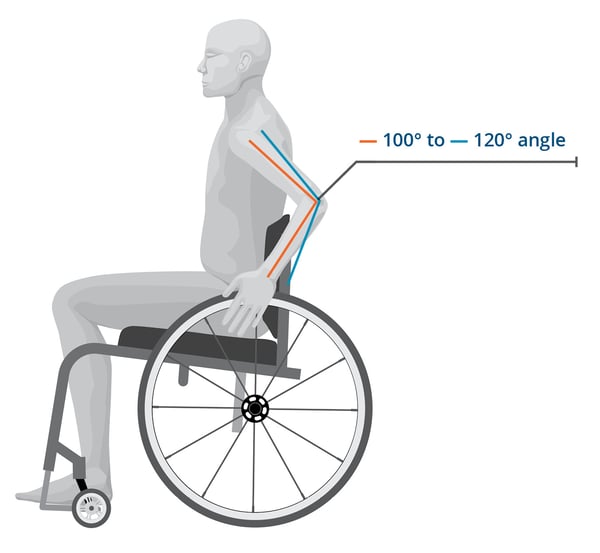
The ideal seat height and axle position is when the angle between the upper arm and forearm is between 100° - 120° when the hand is resting on the top center of the pushrim.
Click on the other propulsion topics below to learn more.
%20(1).jpg)
Chapter 4
Power assist is the use of technology to assist with the “push” phase of independent manual wheelchair propulsion. This technology can reduce the push frequency and force required for effective mobility. Power assist can be hub-mounted or rear-mounted. Both styles allow for the rear wheels to be removed, but the weight of the hub-mounted devices are significantly more because there are two motors and batteries, instead of one. A rear-mounted power assist does not require pushing to activate it which frees the hands for function.
Although the common misconception is that power assist is used for clients who have pain in their shoulders from overuse, this is a REACTIVE way to use power assist.
What about those wheelchair users who want to be PROACTIVE and use power assist to prevent an overuse injury? Some examples include:
There are different types of power assist devices on the market today. Click on each type to learn more about that option along with the benefits and considerations of each.
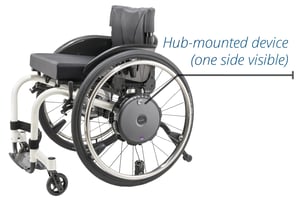

Chapter 5
.jpg)
A fully customizable wheelchair made of lightest high-strength materials will:
We maximize client potential through a custom fit.
The evidence-based recommendation from RESNA's position paper "The Application of Ultralight Manual Wheelchairs" states that, "The person cannot conform to the wheelchair, but the wheelchair must conform to the individual." By doing this, we...
| Frame dimension | Pro Tip
Pro tips are not all inclusive and do not take the place of a skilled wheelchair seating and mobility evaluation |
|
| Seat width |
Width should only be as wide as necessary, allowing for use of frame to promote postural alignment, improve wheel access, and maximize environmental access |
|
| Seat depth |
Maximize support of the upper leg and pressure distribution without interfering with posterior aspect of lower leg |
|
| Frame depth |
Match frame to client proportionally to the upper leg Bend of frame should start at popliteal fossa |
Matching the frame proportionally to the client results in better weight distribution and unloading of casters, easing propulsion |
| Ergo seat |
Select a size that goes at least 1” past the greater trochanter |
For best results, your demo should have an ergo seat |
| FSTFH |
Must consider the cushion being utilized when selecting Consider transfers, access under tables, desks, and clearance required under foot plate Seat slope is the difference in front and rear seat heights |
Most adults require between 17-19.5” for front seat height The more bend in the knee, the lower the seat to floor height required for adequate clearance at foot plate |
| RSTFH |
Use rear seat height to maximize wheel access and achieve a more efficient push |
Must consider how much seat slope the individual can manage functionally and any range of motion limitations. With client’s upper extremity extended down to the side, middle finger should be at bottom of wheel hub |
| Overall frame length or front frame angle |
Select so that frame is proportional to the length of the client’s side profile while sitting in the desired position |
Consider hamstring length, spasticity, overall length of wheelchair Overall frame length is inherently more accurate than choosing a front angle, so use overall frame length in conjunction with seat depth and custom frame depth |
| Footrest width |
Select a width that allows for adequate space for the client’s feet and tapers to the client’s desired position |
Consider 0.5” on each side Consider transfer style and types of footwear worn |
| Seat back height |
Select a seat back height that allows the prescribed back support to reach desired height for adequate postural support |
Have your back support demo on the wheelchair |
| Seat back angle |
Select seat back angle that results in desired support, balance, and optimal spinal curves when seated |
|
| Center of gravity |
Ideally 80% of the client’s body weight on the rear wheel. Achieved this by bringing the rear wheel forward, reducing the amount of weight on the front casters and improving wheel access |
With the client’s upper extremity extended down to the side, middle finger should be at center of rear axle, or with client in wheelie, caster should be 2" - 4” off ground 2.5” to 3.5” is typically a good starting point |
| Camber |
Eases initiation of movement and turns, increases lateral stability and, therefore, functional width of wheelchair |
Can negatively impact accessibility with adult wheelchairs if >3° |
| Wheel spacing |
May use in combination with camber to achieve a neutral shoulder alignment during propulsion, impacts functional width of the WC |
|
| Wheel size |
Select a wheel size that allows for 100-120° of elbow flexion when the client is at the start of a push stroke |
Set seat to floor height first in order to achieve postural stability and environmental access. Then apply the correct wheel size for optimal wheel access |
Click here to download the Manual Wheelchair Guide as a PDF.
Click here to view the glossary for the guide.
Click here to view the list of references.
1. Lisa K. Kenyon, Maria Jones, Becky Breaux, Jessica Tsotsoros, Tonya Gardner & Roslyn Livingstone (2019): American and Canadian therapists’ perspectives of age and cognitive skills for paediatric power mobility: a qualitative study, Disability and Rehabilitation: Assistive Technology, DOI: 10.1080/17483107.2019.1606858
2. Whitney, P. G., & Green, J. A. (2011). Changes in infants’ affect related to the onset of independent locomotion. Infant Behavior and Development, 34 (3), 459–466. https://doi.org/10.1016/j.infbeh.2011.05.001
3. Stavness, C., (2006). The effect of positioning for children with Cerebral Palsy on upper-extremity function: A review of the evidence. PT and OT in Pediatrics, 26,39-52)
4. Kenyon, L. K., Schmitt, J., Otieno, S., & Cohen, L. (2019). Providing paediatric power wheelchairs in the USA then and now: a survey of providers. Disability and Rehabilitation: Assistive Technology, 1-10. https://www.tandfonline.com/doi/abs/10.1080/17483107.2019.1617358?journalCode=iidt20